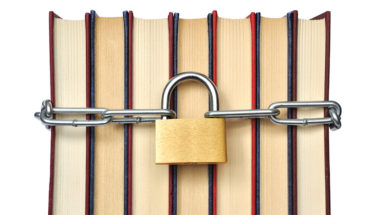More than ever, being a librarian is an act of bravery.
Library Twitter and news outlets are full of stories of parent groups, school boards, and politicians in the U.S. trying to prevent students from having access to books that somehow don’t align with their world view. Books about racism, books with LGBTQ characters, and books on challenging topics like sexual assault are being pulled from the shelves of classrooms and libraries, often with little or no process or recourse. In one high-profile example, a school board in Tennessee banned Art Spiegelman’s Pulitzer-prize winning graphic novel Maus because of “rough, objectionable language.” Librarians are being attacked personally and professionally. Authors, librarians, and other right-to-read advocates are organizing to respond to these challenges, but it’s a bit like playing whack-a-mole. The American Library Association is reporting a greater number of challenges in the U.S. than has ever been reported.
 I’m an American librarian who has spent my career in American/international schools abroad, so book censorship “back home” and abroad are both important to me. A casual survey of my international school library colleagues suggests that the wave of book banning hasn’t reached our schools with as much force as schools in the U.S., although some have noticed an increase. While those of us working internationally haven’t been facing the volume of parental challenges that many U.S. schools are experiencing, we sometimes work under government restrictions that limit our students’ access to books. I’ve worked in places where entire groups of people, religions, and even countries are forbidden topics. Yet, it’s imperative that my students have access to those ideas, just as it’s imperative in the U.S.
I’m an American librarian who has spent my career in American/international schools abroad, so book censorship “back home” and abroad are both important to me. A casual survey of my international school library colleagues suggests that the wave of book banning hasn’t reached our schools with as much force as schools in the U.S., although some have noticed an increase. While those of us working internationally haven’t been facing the volume of parental challenges that many U.S. schools are experiencing, we sometimes work under government restrictions that limit our students’ access to books. I’ve worked in places where entire groups of people, religions, and even countries are forbidden topics. Yet, it’s imperative that my students have access to those ideas, just as it’s imperative in the U.S.
While the circumstances of librarians based in the U.S. and those who work abroad are different, we share a common goal: developing collections for our students that ensure they have opportunities to see themselves and learn about the world.
Protecting Mirrors, Windows, and Sliding Glass Doors
 In 1988, Emily Styles wrote that curriculum should offer students both windows and mirrors, “in order to reflect and reveal most accurately both a multicultural world and the student herself or himself.” In 1990, Rudine Sims Bishop took the metaphor one step further, saying, “These windows are also sliding glass doors, and readers have only to walk through in imagination to become part of whatever world has been created or recreated by the author.”
In 1988, Emily Styles wrote that curriculum should offer students both windows and mirrors, “in order to reflect and reveal most accurately both a multicultural world and the student herself or himself.” In 1990, Rudine Sims Bishop took the metaphor one step further, saying, “These windows are also sliding glass doors, and readers have only to walk through in imagination to become part of whatever world has been created or recreated by the author.”
School librarians around the world have embraced the windows, mirrors, and sliding glass doors mentality as we curate collections for our students. In American international schools, the process of collection development can take on an added dimension. Our schools are based on an American model in an international setting, and our student populations include Americans, host country nationals, and children from dozens of countries around the world. Each of those students bring with them their culture, religion, and beliefs, and our libraries need to provide ways to reflect all of them.
Despite our different settings and circumstances, librarians in the U.S. and abroad can employ similar steps to protect ourselves, our libraries, and our students’ right to read.
Establish Library Policies and Get Board Approval
For guidance, the American Library Association (ALA) is a great place to start. The ALA recommends that every library has a material selection policy, a deselection policy, and a challenge policy. Those policies should be based on the school’s and library’s guiding statements. Further, the ALA says: “The policy should be approved by the library’s governing board or other policy-making body and disseminated widely for understanding by all stakeholders.”
When I move to a new school, it’s important to determine the school’s policies and the guidelines and protections they offer. Some questions to consider:
- Does the library have guiding statements such as a mission, vision, or philosophy?
- If so, are they strong? If not, the library team should write them and present them to the admin for approval. The guiding statements should be public and featured on your library website.
- Are there selection, de-selection, and challenge policies in place?
- If so, do they align with the guiding statements? Are they current? Are they strong? If not, the library team should write them and present them to the admin for approval.
- Is there a board policy concerning the libraries?
- Does it support the library’s internal policies? If so, consider publicizing that policy on your library website.
This starts as a conversation among the library team, and when we’re confident that the policies reflect our beliefs and best practice, we share the policies with our teaching colleagues and administrators.
The next step is to ensure that the library’s policies are approved and supported by a board-level policy. In effect, having a board policy about the library says that:
- the board is empowering the librarians to create and follow a selection policy
- the board approves of the selection policy
- as long as the selection policy is followed, the board stands behind the materials selected
It also articulates the procedures to be followed should a member of the community disagree with something that’s been selected. Having this approved at the board level provides protection for the library staff and the school should community members decide to challenge the types of materials our library holds or the materials we get rid of. A board policy specific to the library is integral to our profession and standard for all good school library programs.
Depending on your school’s structure, getting access to the board can be the most challenging part of this process. I’ve been fortunate to work with administrators who are willing to listen to the case the librarians make and then advocate for an audience with the board. Building that relationship is dependent on demonstrating my understanding of the profession, doing my job well, and communicating both success and challenges regularly. An annual report is an effective way to share the work of the library program with administrators, community members, and the board. Contributing to school bulletins and newsletters, offering parent workshops, opening up the library for school or community events, volunteering at PTA activities, and attending student games and performances are all ways to meet community members who might then become library advocates.
It often just takes getting one person to listen in order to get the policy approval process started. In one school I worked at, the superintendent expanded our proposed policy to include selection of classroom materials as well as script and music selection for performances. In another school, the board chair wrote to me and asked, “Why is this necessary?” When I replied with examples and links to the ALA website, she took the policy even further than our proposal. The school now has an intellectual freedom policy that protects all teachers and administrators. In yet another school, the superintendent offered the librarians an opportunity to present at a board meeting; we had 30 minutes to talk about the importance of school libraries and the status of our library before asking them to consider the proposed policy.
Having board-approved challenge, selection, and de-selection policies is like having insurance: you hope you never have to use it. Unfortunately, that situation appears to be changing around the world. I’ve had many conversations with parents over the years who were concerned about specific titles, but I was always able to resolve the situation by listening carefully and then having a thoughtful conversation. But, for the first time in my career, I’m seeing challenges that continue through the entire process. I’m so thankful that the challenge policies are in place.
At a former school, I was invited to speak to a middle school class about my profession. I’ll never forget the look of disbelief on their faces when I told them that being a librarian required bravery. At the time I was working in a country that tried to restrict students’ access to books about human sexuality, but with admin and board support and some creative maneuvering, we were able to build a collection for all of our students. On a library evaluation that year, one student wrote: “I was surprised to find books about homosexuality in the library. It made a queer kid like me feel welcome.” That comment continues to inspire me to develop collections that serve as mirrors, windows, and sliding glass doors for all of my students.
It’s easier to be brave when there are policies and procedures in place to protect us.
See also:




